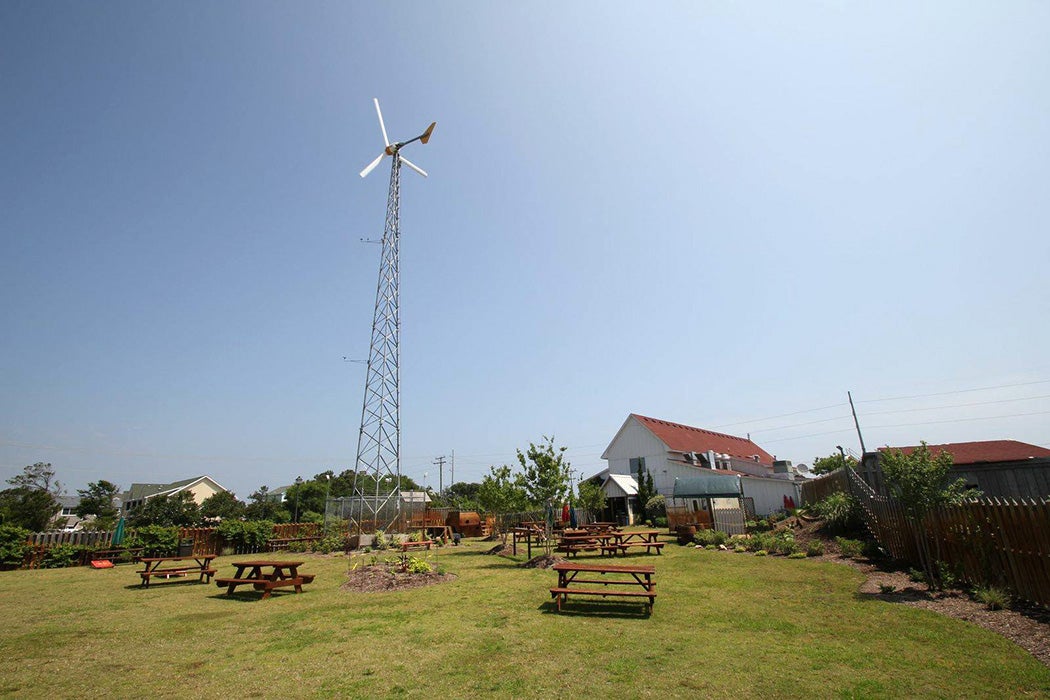Oktoberfest is always a festive time at North Carolina’s Outer Banks Brewing Station. But this year it has something special to celebrate. In 2008, its owners Eric Reece and Aubrey Davis installed a wind turbine to generate electricity to power the brewing equipment and the pub. With a price tag of $50,000, the partners estimated it would take them 11 years to break even. This year, they are finally reaching that goal.
Although the investment was costly, the partners say it made a lot of sense. North Carolina’s Outer Banks are famous for their predictably strong air currents. These winds were appreciated by the area’s early settlers, who built windmills for grinding corn.
Those same airstreams lifted and carried the Wright Brothers’ gliding flying machine in 1903, one of the earliest recorded instances of human flight. When the two inventors were looking for a place to try their flying apparatus, they chose the small fishing village of Kitty Hawk because of its steady strong winds. “We came down here for wind and sand, and we have got them,” Orville Wright wrote. The brothers weren’t the only ones who thought of harnessing the area’s natural wind power. Reportedly, in 1906, a small boy on Church’s Island hauled “freight for the people of his village on a car furnished with a sail and propelled by the wind.”
In 2011, the Union of Concerned Scientists stated that America’s wind resources can and should be harnessed to produce clean electricity, free of air and water pollution, greenhouse gas emissions, and waste products. When well-positioned and well-managed, wind power is one of the most cost-effective electricity sources—it can produce energy at prices competitive with new natural gas plants and cheaper than new coal and nuclear plants. Wind can also supply clean power for electric vehicles, lowering people’s dependence on fossil fuels—and thus helping transition to a sustainable energy future.
Because wind turbines require no fuel and produce no waste, the power they generate comes with fewer risks compared to conventional energy sources, which can suffer from explosions, fuel spills, or toxic leakages in case of radioactive waste. Currently, wind turbines in the United States provide more energy than any other renewable source, including hydroelectric power. And while that constitutes only eight percent of the country’s entire generating capacity, Department of Energy estimates that, if by 2030, about 20 percent of American electricity comes from wind power, annual CO2 emissions from power plants could be cut by 30 percent compared to 2005 levels.
Reece and Davis realized that potential fifteen years ago. They first conceived the idea of installing a turbine around 2002, but it took them five years to pass the project through the local authorities for approval—at the time, wind energy was a novelty in the area. Building the turbine took another half year or so, and required an engineer, a land surveyor, and a construction crane—but the project made a lot of sense. “Sitting in the shadow of the Wright Memorial and taking note of the wind conditions here, a windmill seemed the perfect choice for us,” adds Davis. His grandfather met Orville and Wilbur Wright in 1902, when they were loading their gliders to practice takeoffs at Kitty Hawk.
Weekly Newsletter
“We really wanted to start the conversation about wind power here,” Reece says. “There were no windmills on this beach at the time, and there should have been one.”
The windmill produced its first power in 2008, and while it doesn’t power the brewery entirely, the owners calculated that it has saved them about $300—or approximately 8 to 10 percent–on electricity every month. More importantly, over its 30-year lifetime, it will prevent 250 tons of greenhouse emissions from being spewed into the atmosphere.
Now, more than a decade later, the turbine has finally paid for itself, thanks to electricity savings and green energy tax breaks—so the partners plan to toast to that with their dark lagers, fruity IPAs, and a lemongrass wheat ale (among other offerings). Had the legendary Wright Brothers still been around, they’d certainly rise their pints to that.







